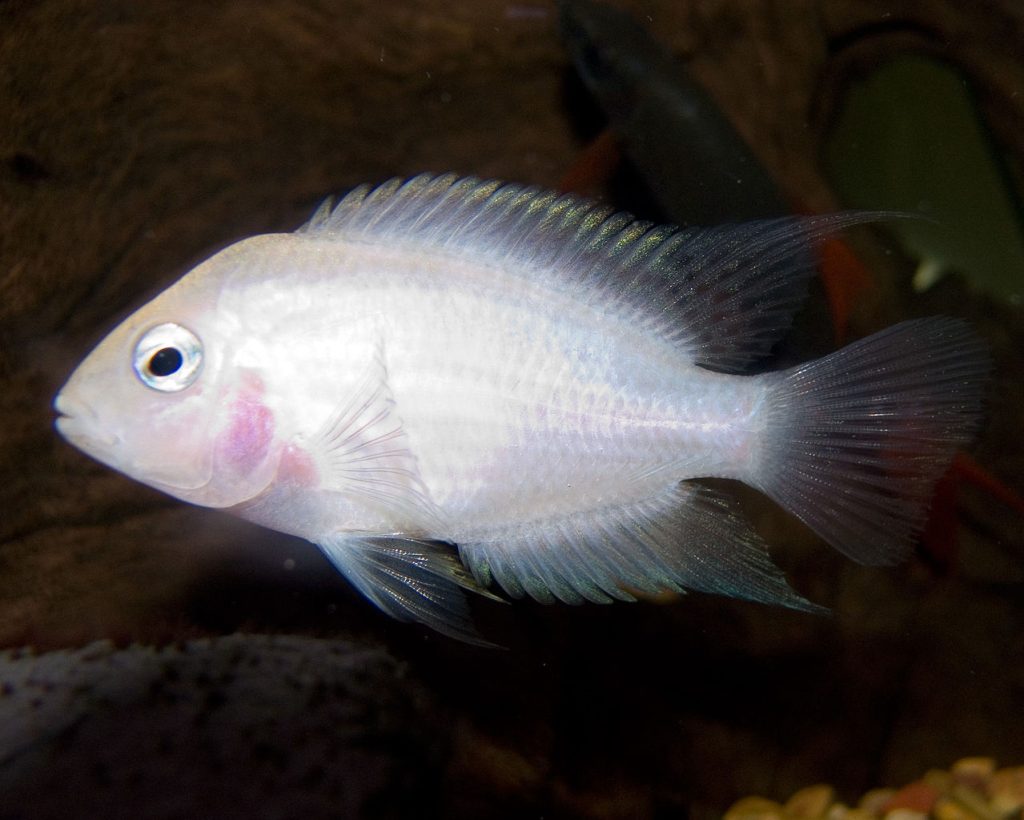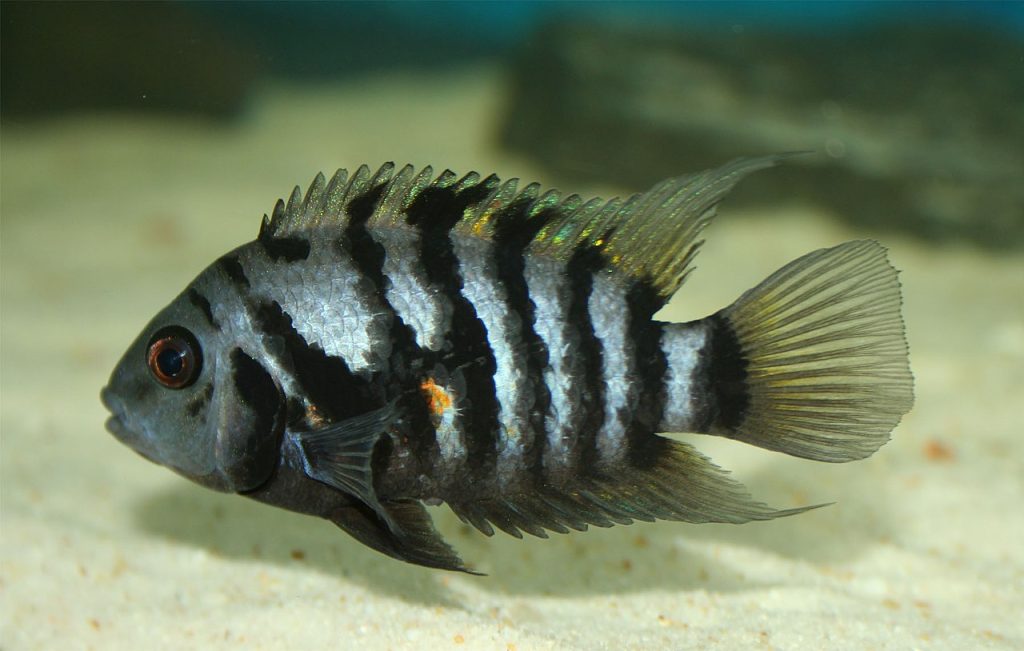The Convict Cichlid, also known as the Convict Fish, is a vibrant freshwater fish that brings a dynamic presence to any aquarium. This particular species is not only beloved for its bold coloration but also for its robust nature, making it a suitable addition for both novice and experienced aquarists. It is a relatively undemanding fish, but it still appreciates attention to detail in its tank conditions. They are not only attractive but are also full of personality, often dazzling their keepers with their interesting behaviors and interaction with their environment.
| Common name: | The Convict Cichlid, has earned its common name from none other than its distinctive markings. You might be curious about the origins of such a name for a fish. It’s quite straightforward – take a look at this species, and you will notice the prominent, vertical black stripes adorning their body. These stripes are reminiscent of old-fashioned prison uniforms, which were traditionally striped. In fact, these markings were so iconic that British convicts were often depicted wearing them, hence the name ‘convict’. They are also known as Zebra Cichlid due to the striped pattern. |
| Scientific name: | The Convict cichlid is scientifically recognized as Amatitlania Nigrofasciata. This name reflects your fish’s defining characteristics: Amatitlania, possibly influenced by its Central American habitat, and Nigrofasciata describing the black stripes adorning its body. They are part of the Cichlidae family. Throughout the years, the Convict cichlid has been known by different scientific names. However, today the name Amatitlania Nigrofasciata is widely accepted. |
| Care Difficulty: | Caring for Convict Cichlids can be easy to moderate, depending on your experience level with aquariums. If you’re a beginner, you might find their needs straightforward compared to other freshwater species. They are known to be hardy, tolerating varying conditions once acclimated. |
| Adult Size: | When you’re considering adding Convict cichlids to your aquarium, it’s important to understand how large they can get. As you provide care for them, you’ll see that Convict cichlids are relatively small compared to other cichlids. Here’s a quick glance at their sizes: Average Size: 4-5 inches Males tend to be slightly larger, reaching up to 6 inches. Females are often smaller, with an average size of about 4.5 inches. Remember, growth can vary based on factors like genetics, general health, and aquarium conditions. For optimal health and well-being, you should ensure they have an adequate tank size to accommodate their fully grown proportions. |
| Original Origin: | You might be wondering where the Convict cichlid, with its distinctive stripes, originally comes from. This striking fish is native to Central America. More specifically, its origins trace back to the warm waters of countries such as Nicaragua, Costa Rica, and Panama. In the wild, you’d find these cichlids in diverse water bodies. They inhabit: – Rivers – Streams – Small ponds |
| Tank Size/Setup: | To create an ideal environment for Convict Cichlids, it’s crucial to consider the tank size and setup. Here are key points to keep in mind: Tank Size: Convict Cichlids are relatively small but highly territorial fish. A minimum tank size of 20 gallons is recommended for a pair. For a community tank or to accommodate more fish, a larger tank is necessary. Aim for at least 40 gallons to provide ample space for territories and swimming. Tank Setup: Substrate: Use fine-grained gravel or sand to mimic their natural habitat and facilitate their digging behavior. Decor: Include plenty of hiding places such as caves, rocks, and driftwood. This helps reduce aggression and stress among fish. Plants: While not essential, live or artificial plants can provide additional cover and enhance the tank’s aesthetic. Choose hardy species as Convict Cichlids may uproot delicate plants. Filtration: A robust filtration system is important to maintain water quality, as Convict Cichlids produce a significant amount of waste. Lighting: Standard aquarium lighting is sufficient. It can be on a timer to provide a consistent day-night cycle. Remember, regular water changes and monitoring of water parameters are essential to maintain a healthy environment for your Convict Cichlids. |
| Temperament / Compatibility: | When creating a community aquarium, understanding the temperament of your fish is crucial, especially when it involves the Convict Cichlid. These are aggressive and territorial fish, so you need to be strategic about their tank mates. – Male Convict Cichlids can be particularly territorial. – They exhibit dynamic behavior — active and robust. For a harmonious tank, consider these pointers: – Size Matching: Pair Convict Cichlids with fish of similar or larger size to lessen aggression. – Disposition: Choose tank mates with compatible temperaments; other cichlids like the Firemouth or even some catfish species. – Personal Space: Ensure ample space for each fish to establish territories, reducing the chance of conflict. Groups: – Smaller groups (1-6) are manageable in a home aquarium. – Larger groups need more consideration for space and environmental needs. Suggested Tank Mates: – Larger Cichlids – Catfish – Plecos Remember to monitor their behavior regularly for signs of aggression and make adjustments as needed to maintain a peaceful tank environment. |
| Water Temperature: | Paying attention to water temperature is key to creating a comforting environment for your fish. They will thrive in water temperatures ranging from 72°F to 84°F (22-29°C). This range supports their health and encourages typical behaviors seen in their natural habitat. Here’s a simple guide to the ideal temperature ranges: Active Behavior: 72-78°F (22-26°C) General Comfort: 75-79°F (24-26°C) Breeding Conditions: 79-84°F (26-29°C) Keep in mind, Convict Cichlids are hardy and can tolerate some variation, but for their utmost well-being, stick to the recommended temperature guidelines. |
| Water Hardness: | Ideal Range: Your Convict Cichlids will thrive in water with a hardness level between: – 6 to 15 dGH (General hardness) – 8 to 15 dGH (This range is often cited as optimal) |
| Water pH: | The water pH for Convict Cichlids should be slightly acidic to neutral: Ideal pH Range: 6.5 to 7.8 Optimal Conditions: Aim for a stable pH of about 6.6 to 7.5 |
| Fish Food: | These fish are omnivores, so they enjoy both plant and animal matter. Staple Diet: – Pellets: Specially formulated cichlid pellets should be the mainstay of their diet. These provide essential nutrients tailored for cichlids. – Flakes: High-quality flakes are also suitable for Convict Cichlids and can offer a diverse range of nutrients. Supplemental Foods: – Live Foods: Brine shrimp, bloodworms, and daphnia are excellent choices for protein. – Vegetables: Peas, zucchini, and cucumber can be blanched and given as a treat. Remember to moderate the quantity to prevent overfeeding. As a general rule, feed them an amount they can consume in two minutes. Feeding Schedule: Feed your Convict Cichlid once or twice a day. Observation Tip: Keep an eye on their feeding habits — uneaten food should be removed to maintain water quality. |
| The Sexes: | When you’re trying to distinguish between male and female convict cichlids, there are a few key characteristics to pay attention to. Males generally grow larger than females, with males reaching up to 6 inches in length in captivity. On the other hand, females are typically around 4.5 inches when fully grown. Body Shape & Coloration: – Males: More streamlined with a larger and more pointed dorsal fin. – Females: Often display a more rounded body with a less pronounced dorsal fin. They can also exhibit a greenish hue or orange spots on their belly, especially when breeding. Fin Features: – Dorsal and Anal Fins: Males might boast elongated and pointed fins, whereas females usually have shorter and rounder fins. |
| Breeding: | When breeding Convict Cichlids, you’ll want to provide the best environment for your fish. Consistent water quality is crucial; aim to maintain clean conditions by performing a water change of 20-25% every three days. Your aquarium setup is key. A minimum of 30 gallons is recommended for housing a breeding pair. Larger tanks are beneficial as they increase spawning success. For optimal breeding, the temperature should be slightly raised, which encourages spawning behavior. Here’s a quick checklist for breeding Convict Cichlids: – Tank Size: Minimum 30 gallons for a pair. – Water Changes: 20-25% every three days. – Temperature: Slightly raised to promote breeding. – Tank Environment: Include hiding places for stress reduction. Male Convict Cichlids display distinct behaviors when ready to mate – they become more territorial and may display brighter colors. You’ll notice the male courting the female with an energetic dance. Once the female lays her eggs, usually in a cave or on a flat surface, both parents exhibit protective behaviors. Monitor the Fry closely after the eggs hatch. The fry grow quickly and will need an environment that supports their development, with proper filtration and continued good water quality. It’s essential to remove any uneaten food and waste, using a gravel vacuum, as cleanliness is vital for the health of the fry. Stick to a cleaning schedule for consistency. |
| Average Lifespan: | These fish generally have a lifespan of 8 to 10 years, given that they are in an environment that meets their needs. |
| Comments: | Incorporating Convict Cichlids into your aquarium can be quite rewarding. Their lively behavior and parenting habits are fascinating to observe. With proper care, Convict Cichlids make a delightful addition to both novice and experienced aquarists’ tanks. |





Leave a Reply